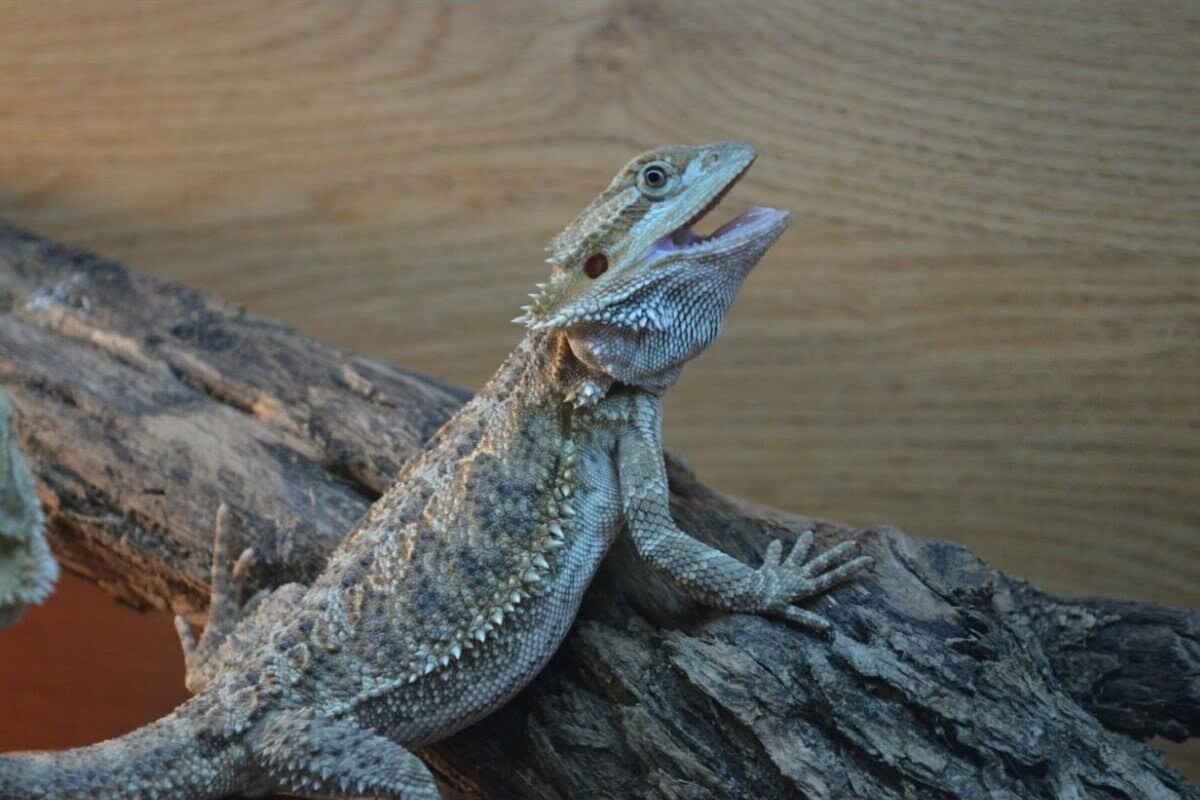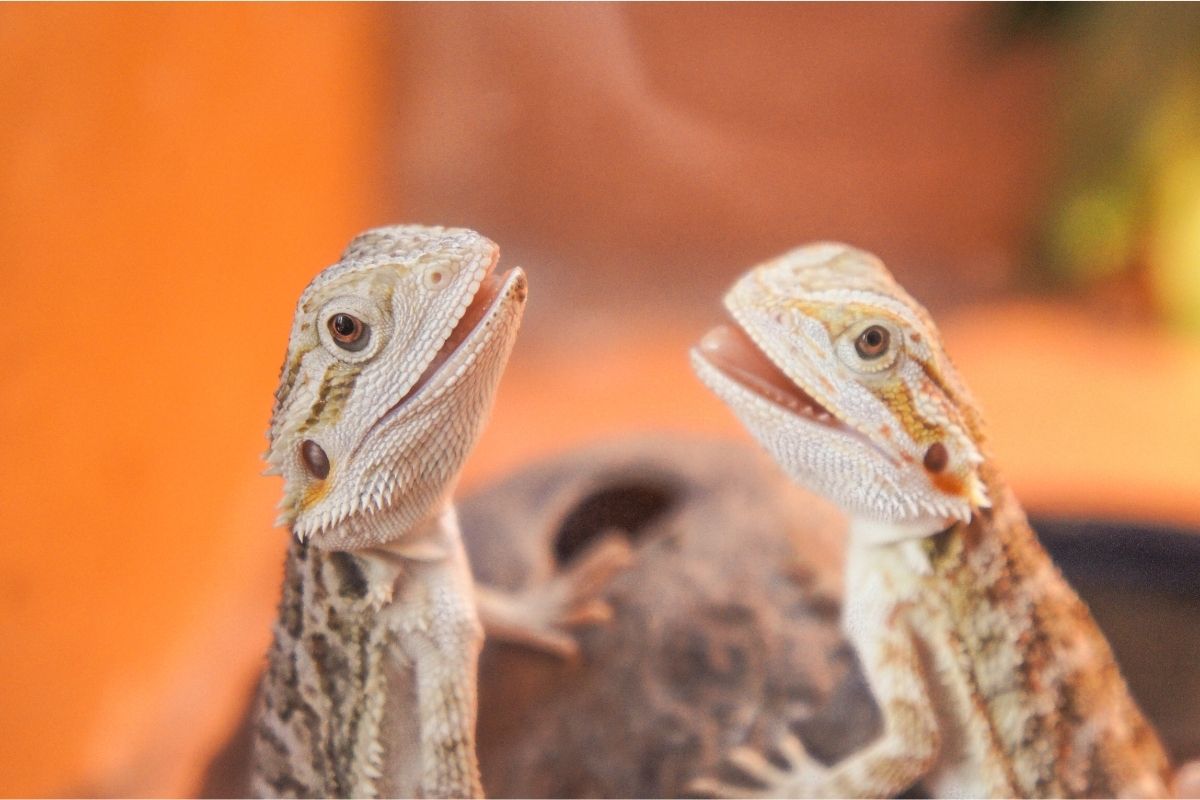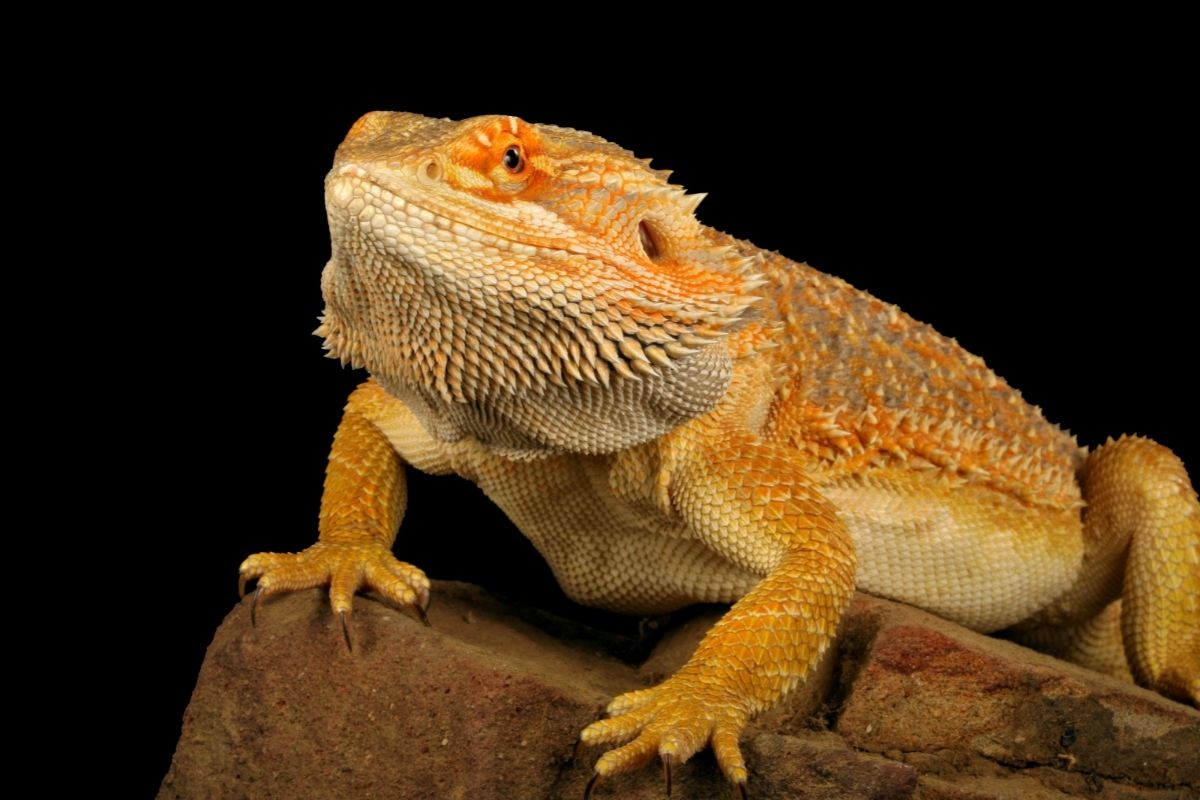It’s easy to assume that only chameleons change their color. While healthy bearded dragons typically have a pale green coloration, they can also change their skin color under certain conditions.

Bearded dragons are one of the most popular reptiles available today. They are easy to care for, beautiful, and fun to watch.
However, like all reptiles, beards need to eat and drink regularly if they are going to stay healthy.
If you want your beard to look its best, it is important to feed them properly and give them the right care.
We take a look at why bearded dragons naturally turn black and what you can do about this.
Why Do Bearded Dragons Change Their Skin Color To Black?
Bearded dragon owners often ask why their bearded dragons turn black now and then.
Here are the three most common reasons for a black beard.
Temperature
Most people think it is because the lizard has been exposed to too much sun and heat. But this isn’t true. In fact, it’s quite the opposite.
Bearded dragons turn black when their surrounding temperature is too cold.
Bearded dragons are exothermic. This means that their body temperature depends on the surrounding temperature.
Wild bearded dragons can easily regulate their temperature by moving from a sunny spot into a shade or vice versa.
But captive-bred bearded dragons don’t have this luxury, and this is the reason you need to create different climate zones in your animal’s tank.
You should make sure that you have a hot area and a cold area in the tank to ensure your bearded dragon is never too cold or hot.
In case your bearded dragon feels cold, it can go to the warm zone, and when it feels too hot, it can go to the cooler area of the tank.
You should always have a good lighting system with UVB lights in your reptile’s tank to provide a higher temperature in the warm tank zone.
This will help your bearded dragon stay warm, which is important for its health.
It is normal for a bearded dragon to turn black, especially overnight, when you turn the light off. The black color allows the reptile to capture more of the warmth.
You may even notice them lying very flat on the ground when they are black. This is so they can absorb more of the light and bring their body temperature up.
Stress
However, there may also be another reason why your bearded dragon turns black: stress.
Stressed bearded dragons tend to lose their appetite, become lethargic, and even develop diarrhea.
When these symptoms occur, and your bearded dragon is black for longer than a few days, then you should take it to the vet.
Usually, a stressed bearded dragon just needs some time to relax and calm down. This is typically the case when it just arrives at your home.
You should see your bearded dragon’s skin turn normal after a few days.
Feels Threatened
Another reason why your bearded dragon may turn cold is when it feels threatened.
If your bearded dragon turns black when it feels threatened, then you should try to find out what is making it feel threatened.
The most common reasons for this behavior are other animals near the tank.
Try to keep all of these animals away from your bearded dragon. If you cannot do so, then you should place an aquarium cover over the tank.
The cover will prevent your bearded dragon from seeing any potential predators. Once your bearded dragon feels safe again, it will return to its normal coloring.
Sickness
Your bearded dragon may also turn black if he gets sick. Most commonly, this happens when your bearded dragon eats something wrong.
In this case, you should immediately remove the item from the tank and call your veterinarian.
There are many things that can cause sickness in bearded dragons. Some of these include feeding your bearded dragon too much food, not providing enough calcium, and having a dirty tank.
These are only a few examples of what could be causing your bearded dragon to get sick. You should consult your veterinarian about all possible causes.
What’s The Best Lighting For A Bearded Dragon Tank?
There are many types of lighting systems available for bearded dragons. UVB bulbs are great for keeping your bearded dragon warm all year round.
Bearded dragons enjoy bright light, and they need a good temperature to stay active and healthy.
UVB bulbs are perfect for this purpose. However, bear in mind that they require a lot of energy, and they are typically expensive.
However, this is an essential must-have for your pet reptile.
You should also make sure that you have plenty of hides, so your bearded dragon can find shade if it feels too hot.
How To Care For A Stressed Bearded Dragon
If your bearded dragon becomes stressed, then you should try to figure out what is causing it to feel stressed.
Provide Hiding Space
Your bearded dragon may feel stressed because it doesn’t have enough hiding spaces. This means that it has nowhere to hide when it feels threatened. It may start to feel scared or anxious.
In order to avoid stressing your bearded dragon, you should add some additional hiding places.
For example, you could place a log in the corner of the tank. You can also use a small rock pile as well.
This way, your bearded dragon will always have somewhere to retreat to when it feels threatened.
Remove Any Threats
Bearded dragons can feel stressed when they sense a potential threat nearby.

If you see anything like a dog or a cat near your tank, then you should remove it immediately.
It may not seem like a big deal, but it can cause your bearded dragon to feel stressed.
Cover The Sides Of The Tank
Stressful situations can be avoided by covering the sides of the tank with plants. This makes your reptile feel more secure, and it can also use the plants as a hiding space.
Provide The Right Diet
When your bearded dragon is stressed, it tends to eat and drink less. You should always make sure to provide the right diet for your pet.
A high-protein diet helps your bearded dragon to grow and develop properly. It also keeps them healthy and strong.
Symptoms Of A Sick Bearded Dragon
Your bearded dragon may also turn black when it is sick. The symptoms of a sick bearded dragon vary depending on the illness.
Some common signs include:
- Lack of appetite
- Lethargy
- Loss of weight
- Vomiting
- Diarrhea
- Constipation
- Weakness
If you notice that your bearded dragon is black and has the above symptoms, then you should take it to your veterinarian as soon as possible.
Frequently Asked Questions
What Do You Do When Your Bearded Dragon Turns Black?
Typically when a bearded dragon turns black, this is very natural. They may feel threatened, or they may even feel cold.
Depending on the cause, you may need to provide more light for your bearded dragon or remove any possible threats.
If your bearded dragon is black for longer than a couple of days and if there are other symptoms, then you should take it to a vet.
Can You Get A Black Bearded Dragon?
Yes, you can get a black bearded dragon morphs. However, they are naturally very rare, as the black color of a bearded dragon is only a sign of aggression or stress.

How Do Bearded Dragons Turn Black?
There are many reasons why bearded dragons turn black, such as cold weather or stress. They change their skin color in a similar way to a chameleon.
They change different pigments in their skin from their natural green pale color to black.
Do Bearded Dragons Change Color As They Grow?
Yes, bearded dragons do change color when they grow. They are typically a very vibrant color when they are younger and only turn their final pale color when they are mature adults.
Why Is Bearded Dragon Turning White?
The main reason why your bearded dragon is turning white is that it is shedding. Younger bearded dragons shed a lot because they are still growing.
This process will happen every few weeks, so your bearded dragon will be white quite often until it is an adult.
Your bearded dragon may also turn white due to a lack of vitamin D. If you don’t give your bearded dragon enough vitamin D, then it won’t produce melanin pigment.
Melanin is what gives your bearded dragon its dark color. Without it, your bearded dragon will look paler and lighter.
Conclusion
Bearded dragons are one of the most popular reptiles available today because of their smaller size and docile temperament.
Reptiles have been around for thousands of years, and they continue to evolve and adapt to our modern world.
However, they are still vulnerable to predators, parasites, diseases, and environmental changes.
Luckily, there is nothing to worry about when your bearded dragon turns black for a couple of days.
